 W
WAd Parnassum is a pointillist painting by Swiss-born artist Paul Klee. The painting is currently in the Kunstmuseum Bern.
 W
WThe Adoration of the Magi is a painting by the Italian painter Gentile da Fabriano. The work, housed in the Uffizi Gallery in Florence, Italy, is considered his finest work, and has been described as "the culminating work of International Gothic painting".
 W
WAllegory of the Planets and Continents is a 1752 painting by Italian artist Giovanni Battista Tiepolo. Done in oil on canvas, the allegorical work uses human figures to represent members of the Greco-Roman pantheon, the planets, and four continents. The painting is an elaborate oil sketch made by Tiepolo in preparation for rendering a similar, larger version of his scene.
 W
WThe Andes of Ecuador is an 1855 oil painting by Frederic Edwin Church, the premier American landscape painter of the time. It is the most significant result of his 1853 trip to South America, where he would travel again in 1857. It is Church's first major painting, his largest work to date, and "an early masterpiece of Luminism", according to the Reynolda House Museum of American Art in Winston-Salem, North Carolina, which holds the painting.
 W
WThe Battle of Alexander at Issus is a 1529 oil painting by the German artist Albrecht Altdorfer, a pioneer of landscape art and a founding member of the Danube school. The painting portrays the 333 BC Battle of Issus, in which Alexander the Great secured a decisive victory over Darius III of Persia and gained crucial leverage in his campaign against the Persian Empire. The painting is widely regarded as Altdorfer's masterpiece, and is one of the most famous examples of the type of Renaissance landscape painting known as the world landscape, which here reaches an unprecedented grandeur.
 W
WChichester Canal is a painting by the English Romantic landscape painter, watercolourist and printmaker J. M. W. Turner. It was painted in 1828 and was commissioned by George Wyndham, 3rd Earl of Egremont It is now in the Tate Collection.
 W
WCotopaxi is an 1862 oil painting by the Hudson River School artist Frederic Edwin Church. The work was commissioned by well-known philanthropist James Lenox. The painting was met with great acclaim, and seen as a parable of the Civil War, then raging in the South, with its casting of light against darkness. The painting depicts Cotopaxi, a volcano that is also the second highest peak in modern-day Ecuador, spewing smoke and ash across a sunrise. Church also painted another landscape by the same name that also features the volcano in the distance.
 W
WThe Course of Empire is a series of five paintings created by Thomas Cole in the years 1833–1836. It is notable in part for reflecting popular American sentiments of the times, when many saw pastoralism as the ideal phase of human civilization, fearing that empire would lead to gluttony and inevitable decay. The theme of cycles is one that Cole returned to frequently, such as in his The Voyage of Life series. The Course of Empire comprises the following works: The Course of Empire – The Savage State; The Arcadian or Pastoral State; The Consummation of Empire; Destruction; and Desolation. All the paintings are oil on canvas, and all are 39.5 inches by 63.5 inches except The Consummation of Empire which is 51″ by 76″.
 W
WThe Creation of the Sun, Moon and Plants is one of the frescoes from Michelangelo's nine Books of Genesis scenes on the Sistine Chapel ceiling. It is the second scene in the chronological sequence on the ceiling, depicting the third and fourth day of the Creation narrative together in on panel.
 W
WDido building Carthage, or The Rise of the Carthaginian Empire is an oil on canvas painting by J. M. W. Turner. The painting is one of Turner's most important works, greatly influenced by the luminous classical landscapes of Claude Lorrain. Turner described it as his chef d'oeuvre. First exhibited at the Royal Academy summer exhibition in 1815, Turner kept the painting until he left it to the nation in the Turner Bequest. It has been held by the National Gallery in London since 1856.
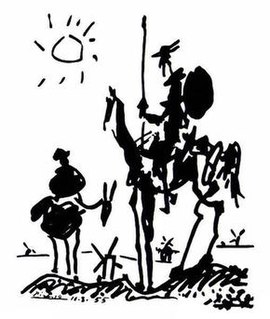 W
WDon Quixote is a 1955 sketch by Pablo Picasso of the Spanish literary hero and his sidekick, Sancho Panza. It was featured on the August 18–24 issue of the French weekly journal Les Lettres Françaises in celebration of the 350th anniversary of the first part, published in 1605, of the Miguel de Cervantes novel Don Quixote. Made on August 10, 1955, the drawing Don Quixote was in a very different style than Picasso’s earlier Blue, Rose, and Cubist periods.
 W
WSeaport with the Embarkation of the Queen of Sheba is an oil painting by Claude Lorrain, in the National Gallery, London, signed and dated 1648. The large oil on canvas painting was commissioned by Frédéric Maurice de La Tour d'Auvergne, Duc de Bouillon, general of the Papal army, together with Claude's Landscape with the Marriage of Isaac and Rebecca, also now in the National Gallery. It depicts the departure of the Queen of Sheba to visit King Solomon in Jerusalem, described in the tenth chapter of the First Book of Kings. A more usual subject would be their meeting; this is one of many harbour scenes painted by Claude. The Queen is departing from a city with classical buildings, with the early morning Sun lighting the sea, as vessels are loaded.
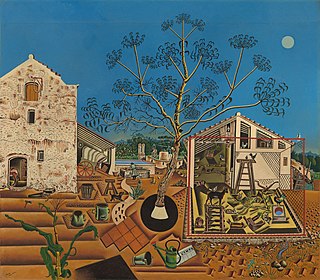 W
WThe Farm is an oil painting made by Joan Miró between the summer of 1921 in Mont-roig del Camp and winter 1922 in Paris. It is a kind of inventory of the masia owned by his family since 1911 in the town of Mont-roig del Camp. Miró himself regarded this work as a key in his career, describing it as "a summary of my entire life in the countryside" and "the summary of one period of my work, but also the point of departure for what was to follow." It is preserved in the National Gallery of Art in Washington DC, where it was given in 1987 by Mary Hemingway, coming from the private collection of American writer Ernest Hemingway, who had described it by saying, “It has in it all that you feel about Spain when you are there and all that you feel when you are away and cannot go there. No one else has been able to paint these two very opposing things.”
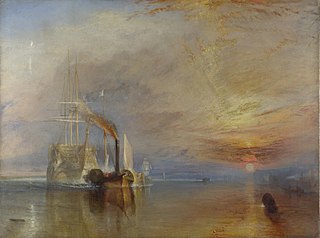 W
WThe Fighting Temeraire, tugged to her last berth to be broken up, 1838 is an oil painting by the English artist Joseph Mallord William Turner, painted in 1838 and exhibited at the Royal Academy in 1839.
 W
WImpression, Sunrise is a painting by Claude Monet first shown at what would become known as the "Exhibition of the Impressionists" in Paris in April, 1874. The painting is credited with inspiring the name of the Impressionist movement.
 W
WLandscape with a View of the Sea at Sunset is a pen and ink wash drawing by Flemish painter Joos de Momper. It was painted in 1610, and is currently housed at the British Museum in London. The drawing is valuable in that it is the only drawing signed and dated by de Momper.
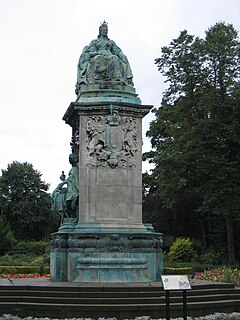 W
WA Memorial to Queen Victoria stands in Woodhouse Moor, Leeds, West Yorkshire, England.
 W
WThe Lion and Sun is one of the main emblems of Iran (Persia), and was an element in Iran's national flag until the 1979 Iranian Revolution. The motif, which illustrates ancient and modern Iranian traditions, became a popular symbol in Iran in the 12th century. The lion and sun symbol is based largely on astronomical and astrological configurations: the ancient sign of the sun in the house of Leo, which itself is traced back to Babylonian astrology and Near Eastern traditions.
 W
WMan Between Vice and Virtue is an 1892 symbolist painting by Henri Martin. The painting is currently housed in le Musée des Augustins, in Toulouse, France.
 W
WMercury Passing Before the Sun is the title of a series of paintings by Italian Futurist painter Giacomo Balla, depicting the November 17, 1914 transit of Mercury across the face of the Sun.
 W
WThe Nebra sky disc is a bronze disc of around 30 centimetres diameter and a weight of 2.2 kilograms (4.9 lb), having a blue-green patina and inlaid with gold symbols. These symbols are interpreted generally as the Sun or full moon, a lunar crescent, and stars. Two golden arcs along the sides, interpreted to mark the angle between the solstices, were added later. A final addition was another arc at the bottom with internal parallel lines.
 W
WNorham Castle, Sunrise is an oil on canvas painting by English painter J. M. W. Turner, created around 1845. The painting was bequeathed to the National Gallery of British Art as part of the Turner Bequest in 1856. It remains in the collection to this day.
 W
WThe Peace Fountain is a 40-foot-high (12 m) sculpture and fountain located next to the Cathedral of St. John the Divine in the Morningside Heights section of Manhattan in New York City. It was commissioned in 1985 by Greg Wyatt, sculptor-in-residence at the cathedral.
 W
WThe Red Vineyards near Arles is an oil painting by the Dutch painter Vincent van Gogh, executed on a privately primed Toile de 30 piece of burlap in early November 1888. It depicts workers in a vineyard, and is believed to be the only painting known by name that van Gogh sold during his lifetime.
 W
WEl Rio de Luz is an 1877 oil painting by American landscape artist Frederic Edwin Church. It is his last large-scale painting of South America, following pieces such as The Andes of Ecuador (1855) and The Heart of the Andes (1859). Like them, the painting is a composite of the many sketches and drawings Church made while traveling in South America twenty years earlier.
 W
WThe Scapegoat (1854–1856) is a painting by William Holman Hunt which depicts the "scapegoat" described in the Book of Leviticus. On the Day of Atonement, a goat would have its horns wrapped with a red cloth – representing the sins of the community – and be driven off.
 W
WSnow Storm: Hannibal and his Army Crossing the Alps is an oil on canvas painting by J. M. W. Turner, first exhibited in 1812. Left to the nation in the Turner Bequest, it was acquired by the National Gallery in London in 1856, and is now held by the Tate Gallery.
 W
WSoleil dans le ciel de Saint-Paul is a 1983 painting in oil on canvas, 73 × 115.5 cm, by Russian-French artist Marc Chagall. It is held in a private collection.
 W
WThe Sun (XIX) is a trump card in the tarot deck. Tarot trumps are often called Major Arcana by tarot card readers.
 W
WSunrise, Inverness Copse is a 1918 watercolour by English artist Paul Nash, which was produced during World War I. It depicts a scene from the Western Front near Ypres in Belgium, and was developed from an eye-witness sketch which Nash drew whilst at the scene in 1917. The drawing is in the collection of the Imperial War Museum, in London.
 W
WThe Three Tetons is an 1895 oil painting by Thomas Moran. It depicts Grand Teton and the neighbouring peaks of Middle Teton and South Teton, from the Idaho side. The National Park Service describes Moran as, after Albert Bierstadt, the "other 'grand' painter of the Tetons".
 W
WTime Unveiling Truth is a painting c. 1745–1750 by the Italian painter Tiepolo. It is now on display in the Museum of Fine Arts, Boston in Boston, Massachusetts. Father Time is shown on a chariot with a scythe uncovering the body of a female figure of Truth.
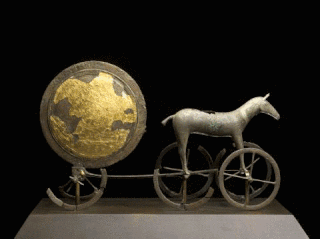 W
WThe Trundholm sun chariot, is a Nordic Bronze Age artifact discovered in Denmark. It is a representation of the sun chariot, a bronze statue of a horse and a large bronze disk, which are placed on a device with spoked wheels.
 W
WThe United Nations Security Council mural is an oil painting by Norwegian artist Per Krohg exhibited at the United Nations in New York City since August 22, 1952. The mural, a 16' x 26' foot long canvas located on the United Nations Security Council's east wall, features a central image of a rising phoenix surrounded by images of war and disharmony, near the mural's bottom, and more tranquil images at the top.
 W
WVädersolstavlan is an oil-on-panel painting depicting a halo display, an atmospheric optical phenomenon, observed over Stockholm on 20 April 1535. It is named after the sun dogs appearing on the upper right part of the painting. While chiefly noted for being the oldest depiction of Stockholm in colour, it is arguably also the oldest Swedish landscape painting and the oldest depiction of sun dogs.
 W
WView of Florence from San Miniato is an oil on canvas painting by American artist Thomas Cole.
 W
WThe Wall of the Sun and Wall of the Moon are a pair of murals made of ceramics and designed by the Catalan artist Joan Miró for the UNESCO building in Paris. The works were carried out by the ceramicist Josep Llorens Artigas in 1955. Initially, the walls were installed on the Place de Fontenoy in Paris, but afterwards were enclosed in a building that was constructed in order to protect them from damage caused by acid rain.
 W
WWar. The Exile and the Rock Limpet is an oil painting of 1842 by the English Romantic painter J. M. W. Turner (1775–1851). Intended to be a companion piece to Turner's Peace – Burial at Sea, War is a painting that depicts a moment from Napoleon Bonaparte's exile at Saint Helena. In December 1815, the former Emperor was taken by the British government to the Longwood House, despite its state of disrepair, to live in captivity; during his final years of isolation, Napoleon had fallen into despair. Turner's decision to pair the painting with Peace was heavily criticized when it was first exhibited but it is also seen as predecessor to his more famous piece Rain, Steam and Speed – The Great Western Railway (1844).
 W
WWashington Crossing the Delaware are three 1851 oil-on-canvas paintings by the German-American artist Emanuel Leutze.
 W
WWe Are Making a New World is a 1918 oil-on-canvas painting by Paul Nash. The optimistic title contrasts with Nash's depiction of a scarred landscape created by a battle of the First World War, with shell-holes, mounds of earth, and leafless tree trunks. Nash's first major painting and his most famous work, it has been described as one of the best British paintings of the 20th century, and compared to Picasso's Guernica. "Yet it is worth remembering that the picture was a piece of official art and that it first appeared, untitled, as the cover of an issue of British War Artists at the Front, published by Country Life. ... [It] was promulgated in 1917 as covert propaganda for the Allied cause."
 W
WThe Wheat Field is a series of oil paintings executed by Vincent van Gogh in Saint-Rémy-de-Provence. All of them depict the view Van Gogh had from the window of his bedroom on the top floor of the asylum: a field enclosed by stone walls just beneath his window and excluded from normal life by the rear wall of the asylum grounds; beyond this enclosure farm land, accompanied by olive groves and vineyards, ran up to the hills at the foot of the mountain range called Les Alpilles.